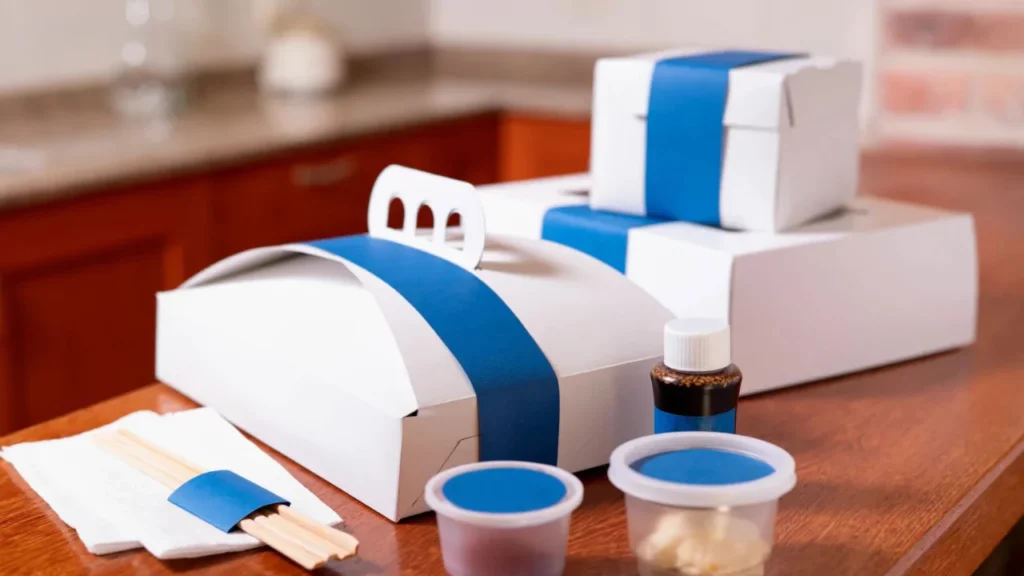Table of Contents
ToggleFood packaging has evolved far beyond being a simple box or bag. Today, it serves multiple purposes—protecting food, ensuring safety, promoting brands, and supporting sustainability. For businesses, especially in food service and retail, bespoke food packaging is no longer a luxury but a necessity.
This guide explores every aspect of bespoke food packaging solutions—from materials and coatings to branding, eco-conscious designs, and real-world problem solving. By the end, you’ll understand how customised packaging helps businesses deliver safe, memorable, and environmentally responsible food experiences.
Why Bespoke Food Packaging Matters
- Tailored Fit for Products
Bespoke packaging is designed to the exact size and shape of your food products. This prevents movement during delivery, reduces spills, and avoids wasted space. A pizza box, for example, shouldn’t be oversized because it can cause the food to slide and lose freshness. - Enhanced Brand Identity
Packaging is the first physical interaction between a customer and your brand. Custom logos, colours, and finishes transform plain boxes into memorable experiences. Brands like Pret and Greggs use consistent packaging designs that customers instantly recognise. - Food Safety and Compliance
Food packaging is regulated to ensure hygiene and consumer protection. Bespoke packaging allows businesses to select certified food-grade materials, inks, and coatings, ensuring compliance with UK and EU standards for direct food contact.
Materials Commonly Used in Bespoke Food Packaging
Choosing the right material is the foundation of effective packaging. Each material serves a different purpose, depending on whether you’re packing hot curries, cold salads, or frozen foods.
- Cardboard and Corrugated Board
Cardboard is lightweight, printable, and suitable for most takeaway packaging. Corrugated board, with its fluted layers, adds insulation and strength, making it ideal for pizzas, family meal boxes, and bulk orders. Thickness is measured in GSM (grams per square metre), where higher GSM means greater durability. - Kraft Paper
Kraft has a natural, rustic look that appeals to eco-conscious customers. It is durable, recyclable, and biodegradable, commonly used for wraps, bakery bags, and takeaway cartons. Its unbleached brown tone communicates sustainability, which is highly valued by today’s consumers. - PET and RPET Plastics
PET is lightweight, clear, and widely used for salads, beverages, and pre-packed meals. RPET (recycled PET) reduces virgin plastic use, aligning with environmental goals. These plastics are sturdy but need careful disposal guidance to avoid contamination in recycling streams. - PLA and Compostable Bioplastics
PLA (polylactic acid) is made from renewable resources like corn starch. It’s fully compostable under industrial conditions, making it a popular alternative for cold foods. However, PLA softens under heat, which limits its use for hot meals. - Aluminium Foil Containers
Aluminium is durable, retains heat, and is both oven- and microwave-safe. It’s often used for baked dishes, curries, or hot deliveries. Being recyclable makes it both practical and eco-friendly, but recycling depends on cleanliness after use. - Hybrid Packaging
Many businesses now use packaging that combines materials—for example, a kraft box with a PLA window or cardboard with bio-based coatings. This approach balances visibility, strength, and sustainability.
Protective Coatings and Liners
Packaging is rarely just raw material. Coatings and liners enhance performance, ensuring food stays fresh and packaging remains functional.
- Greaseproof Coatings
Greasy foods like burgers and pastries quickly stain packaging. Greaseproof coatings create a barrier that prevents oils from soaking through, preserving both presentation and customer comfort. - Moisture-Resistant Liners
Cold or frozen foods often create condensation, which can weaken paper-based packaging. Moisture-resistant coatings help food boxes hold their shape and extend shelf life for items like salads or frozen pizzas. - Bio-Based Laminations
Instead of traditional plastics, plant-based laminations (like corn-starch or sugarcane) strengthen packaging while staying compostable. These are ideal for businesses aiming to reduce environmental impact without sacrificing durability. - Waxed and Double-Lined Papers
For foods with sauces or high moisture content, wax coatings or double linings keep packaging strong. These are commonly used in delis and sandwich shops to prevent leaks. - Microwave-Safe Liners
Special coatings ensure packaging doesn’t release toxins or deform when microwaved. This is critical for ready-to-eat meals sold in supermarkets and takeaways.
Printing, Branding, and Marketing on Food Packaging
Good packaging doubles as a powerful marketing channel. Customers often associate packaging quality with product quality.
- Food-Safe Inks
Packaging in direct contact with food must use non-toxic inks. Options like soy-based, water-based, and UV-cured inks reduce chemical migration risks while supporting eco goals. - Custom Logos and Colours
Consistency across packaging creates strong recognition. Think of McDonald’s red-and-yellow boxes—immediately identifiable, even from a distance. Bespoke designs let you create the same kind of brand recall. - Seasonal and Limited-Edition Designs
Printing seasonal graphics for Christmas, Valentine’s Day, or special promotions keeps customers engaged and boosts repeat sales. Limited editions also create a sense of exclusivity. - Smart Packaging with QR Codes
Adding QR codes to packaging connects customers digitally, offering nutritional details, loyalty rewards, or behind-the-scenes brand stories. This blends offline packaging with online engagement. - Printing Techniques
- Flexographic: cost-effective for large runs.
- Digital: great for short runs and personalisation.
- Offset: high detail for premium packaging like luxury chocolate boxes.
Customisation Options for Different Foods
Not all foods should be packed in the same way. Bespoke options cater to specific product requirements.
- Window Cut-Out Boxes
Clear windows allow customers to see baked goods, chocolates, or sandwiches without opening the box. This transparency builds trust and enhances visual appeal. - Handle Boxes and Carriers
These make transport easier for takeaway combos, coffee-to-go, and catering orders. They combine convenience with strong branding opportunities. - Compartment Boxes
Dividers prevent foods from mixing, which is especially useful for sushi, meal kits, or kids’ lunches. It keeps textures and flavours intact. - Luxury Closures
Premium foods like truffles or hampers often use magnetic closures, ribbons, or embossing. These touches create a luxury unboxing experience that customers associate with quality. - Custom Inserts
Inserts stabilise delicate foods like cupcakes or pastries, preventing movement and damage during delivery. This saves businesses from customer complaints about ruined presentation.
Packaging for Special Functional Needs
Some foods require packaging with advanced properties to handle heating, freezing, or long-distance delivery.
- Microwave-Safe Packaging
Containers for ready meals need to be safe for reheating. Paperboard with microwave-safe coatings, polypropylene plastics, and aluminium trays are commonly used. - Freezer-Safe Packaging
Frozen foods can cause cheap plastics to crack or warp. Freezer-grade plastics and reinforced cartons ensure durability in low temperatures. - Leak-Proof Solutions
Soups, sauces, and curries need secure seals. Bespoke designs include reinforced corners, tight-fitting lids, and inner liners to prevent spills. - Tamper-Evident Packaging
With food delivery booming, tamper-proof seals are critical for customer trust. These give visible confirmation that food hasn’t been interfered with.
Eco-Friendly and Sustainable Food Packaging
Customers increasingly expect eco-conscious packaging, and regulations are pushing businesses to adapt.
- Compostable Options
Materials like PLA, bagasse (sugarcane fibre), and palm leaves naturally decompose, reducing landfill waste. Businesses must, however, educate customers about industrial composting requirements. - Recyclable Packaging
Cardboard, kraft, and RPET are widely recyclable. Clear recycling instructions should be printed on packaging to guide consumers. - Reusable Packaging
Some brands now introduce return-and-reuse systems, especially for coffee cups, coffee sleeves and food containers. This reduces single-use waste while building brand loyalty. - Eco Certifications
Labels such as FSC (Forest Stewardship Council) for paper sourcing or EN 13432 for compostability help customers trust sustainability claims.
Real-World Problems and Packaging Solutions
Bespoke packaging isn’t just about looks—it solves real challenges businesses face.
- Problem: Greasy leaks from fast-food boxes
Solution: Greaseproof food paper liners maintain cleanliness and presentation. - Problem: Soggy chips or pizzas on delivery
Solution: Ventilation holes combined with moisture-resistant coatings keep food crisp. - Problem: Boxes collapse under heavy food
Solution: High-GSM corrugated board with reinforced sides ensures structural strength. - Problem: Branding smudges when exposed to oils
Solution: Use UV-cured inks with protective finishes to keep printing intact. - Problem: Packaging cracks in freezers
Solution: Select freezer-safe plastics and moisture-barrier liners. - Problem: Pastries and cakes ruined in transport
Solution: Inserts and dividers keep items secure and attractive upon arrival. - Problem: Balancing eco-friendliness with costs
Solution: Hybrid designs—like kraft with thin compostable laminations—offer sustainability at manageable prices.
Future Trends in Food Packaging
Packaging continues to evolve with innovation and consumer expectations.
- Smart Packaging
Features like freshness indicators, QR-linked traceability, or RFID chips improve food safety and transparency. - Edible Packaging
Made from seaweed, rice paper, or starch, edible films reduce waste while adding novelty value. - Nanotechnology
Antimicrobial nanocoatings extend shelf life and prevent bacterial growth, improving safety. - Automation-Friendly Designs
Packaging is being engineered for efficiency in automated filling and sealing systems, reducing labour costs and increasing consistency.
Conclusion
Bespoke food packaging solutions are more than just boxes—they’re a blend of safety, branding, sustainability, and problem-solving. Whether it’s choosing greaseproof coatings, microwave-safe containers, or eco-certified materials, each choice affects how customers perceive your food and your brand.
For businesses, investing in bespoke packaging ensures food arrives fresh, safe, and beautifully presented—while reinforcing brand identity and meeting environmental goals. In an industry where first impressions matter, the right packaging can turn a one-time customer into a loyal fan.


